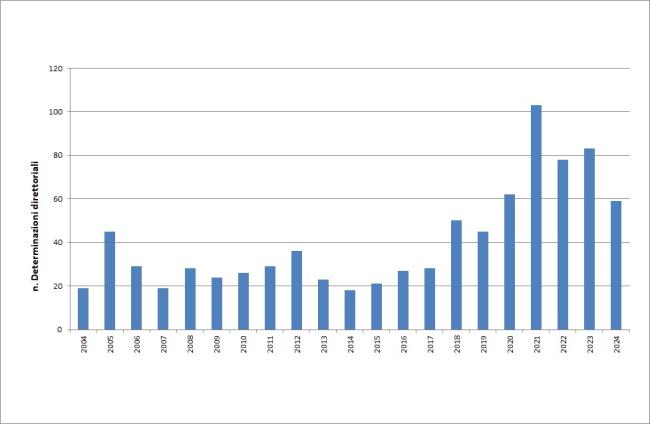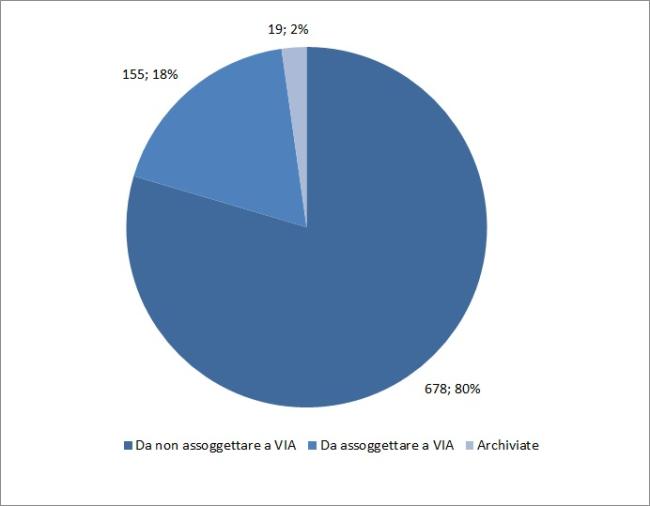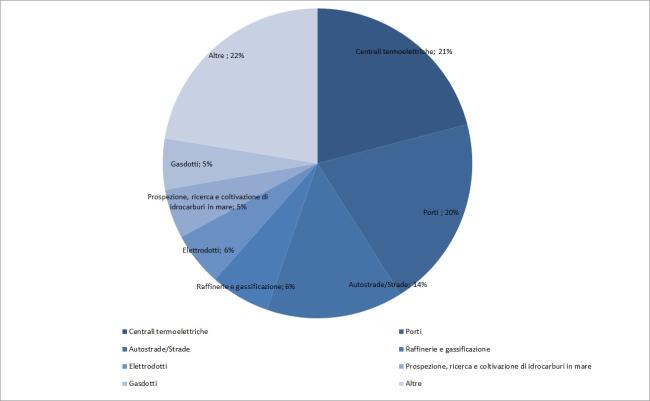Panel 1
Anna Cacciuni, Caterina D'Anna
The indicator represents the number of directoral determinations for Environmental Impact
Assessment (EIA) Screening Procedures (VAV) under national jurisdiction, issued annually by the
Ministry of the Environment and Energy Security (MASE). It provides insight into the central Public
Administration's response to decision-making processes related to environmental assessments.
From 2004 to 2024, there were 678 determinations of non-subjection to EIA, while 155
determinations resulted in subjection to EIA. In 80% of cases, the screening procedure concluded
with a directoral determination of non-subjection to EIA.
The indicator represents the number of directoral determinations for Environmental Impact
Assessment (EIA) Screening Procedures (VAV) under national jurisdiction, issued annually by
MASE.
To provide insight into the central Public Administration's response to decision-making processes
related to environmental assessments.
- Legislative Decree 152/2006 and subsequent amendments
- Legislative Decree No. 104 of 2017
- ecree-Law 34/2020 converted into Law 77/2020
- Decree-Law 76/2020 converted into Law 120/2020
- Decree-Law 77/2021 (Simplification Decree) converted into Law of 29 July 2021, No. 108
- Decree-Law 92/2021: Urgent measures to strengthen the Ministry of Ecological Transition
and in the field of sport - Law No. 25 of 2022
- Law No. 91 of 2022
- Law No. 6 of 2023
- Decree-Law No. 13 of 2023
Panel 2
-
-
Data quality assessment
MASE (Ministry of the Environment and Energy Security)
National
2004-2024
Indicator assessment
The directoral determinations regarding the Screening Procedure for Environmental Impact
Assessment (EIA) under national jurisdiction, issued annually by the Ministry of the Environment
and Energy Security (MASE), have been collected and analyzed. Starting from the determinations
published on the MASE website, data were processed concerning the total number of
determinations of non-subjection to EIA, subjection to EIA, and archived cases for each year.
In 2023 and 2024, the average number of directoral determinations of non-subjection to EIA was
61, while negative determinations (i.e., subject to EIA) were 11 — a number higher than the
average recorded between 1989 and 2022 (Table 1). This highlights an increase in determinations of
non-subjection to EIA, confirming the trend of the past five years and indicating greater attention to
the country’s sustainable and economic development.
Between 2004 and 2024, out of 852 EIA screening procedures examined, 678 determinations were
of non-subjection to EIA, while 155 were negative (i.e., subject to EIA) (Table 1 and Figure 1). A
significant increase in screening determinations is particularly evident from 2018 to 2024,
consistently exceeding the average for the entire 2004–2024 period. This increase demonstrates a
growing awareness of environmental issues.
Data
Table 1: Total number of directorial determinations verifying whether the EIA is a State competence (not to be subject to an EIA, to be subject to an EIA and archived)
ISPRA processing on MASE data
1 Directorial determinations of non-subjection to EIAs are considered positive and partially positive until 2017. Since the entry into force of Legislative Decree 104/2017, "partially positive" determinations no longer exist.
Table 2: Number of directorial determinations to verify the eligibility for EIA (not to be subject to EIA) by type of work
ISPRA processing on MASE data
a No longer subject to state procedure since the entry into force of Legislative Decree 4/2008
Figure 1: Directorial determinations of verification of eligibility for EIA of state competence (Not to be subject to EIA, To be subject to EIA and archived)
ISPRA processing on MASE data
Figura 2: Ripartizione per esito delle detrminazioni direttoriali di assoggettabilità a VIA di competenza statale 2004- 2024
Elaborazione ISPRA su dati MASE
Figura 3: Ripartizione delle determinazioni direttoriali di verifica di assoggettabilità a VIA di competenza statale per tipologia d'opera 2004-2024
Elaborazione ISPRA su dati MASE



The information "number of determinations by type of work" makes it possible to know which and how many works have been subject to verification of subjection that have resulted in non-subjection to the EIA. From 2004 to 2024, the verification procedure ended with a directorial determination of non-subjection to EIA in 80% of cases. The classification adopted for the types of works (Table 2) refers to the categories of Annex II and II bis of Legislative Decree 152/2006 and subsequent amendments, in analogy with the provisions for the "EIA Measures". The type of works subject to verification of eligibility for EIA has undergone changes over the years according to the legislative adaptation to the European directives on the subject. With the amendments introduced by Legislative Decree 104/2017, a thorough revision of Annexes II, III and IV was carried out, reporting the types of projects to be submitted to the various EIA procedures, with the extension of state competences on projects previously attributed to the regions (mainly energy plants and infrastructures) and identification of some projects, previously assigned to the regions and reported in Annex II bis, for which the verification of state subjection is provided for (art. 7-bis). To date, the projects of Annex II to Part II of Legislative Decree 152/2006 are subject to a national EIA and the projects of Annex II-bis are subject to verification of their subjection to a national EIA. On the other hand, the projects of Annex III are subject to a regional EIA and the projects of Annex IV to Part II of Legislative Decree 152/2006 are subject to verification of their subjection to a regional EIA. On the other hand, waste plants are no longer subject to verification of their eligibility for EIA since the entry into force of Legislative Decree 4/2008, which amended Part II of Legislative Decree 152/2006. In relation to the type of work, in the period under review, the directorial determinations of non-subjection to EIA for modification/expansion interventions were: 142 (21%) of thermoelectric power plants, 136 (20%) of port works, 97 (14%) of roads/highways, 42 (6%) of refinery and gasification projects, 38 projects (6%) of power lines, 36 projects (5%) of gas pipelines, 35 (5%), prospection/exploration and production of hydrocarbons at sea, and, finally, 152 projects (22%) in Other (Integrated chemical plants, railway sections, Maritime terminals, Airports, Dams and reservoirs/hydraulic arrangements, Remediation of polluted sites/nuclear plants, Waste, Interports, Gas storage in natural underground tanks, Hydroelectric plants, Port master plans, Off-shore wind farm, Mining exploration permit). (Figure 3). Considering only 2020, 2021, 2022, 2023 and 2024, there are 83 procedures relating to port works, 63 concerning thermoelectric power plants, 46 modifications concerning roads/motorways, 23 concerning gas pipelines (Table 2).